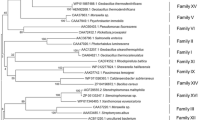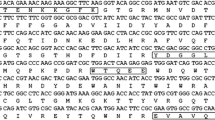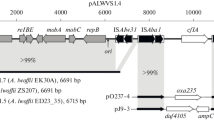Abstract
An epoxide hydrolase gene of about 0.8 kb was cloned from Rhodococcus opacus ML-0004, and the open reading frame (ORF) sequence predicted a protein of 253 amino acids with a molecular mass of about 28 kDa. An expression plasmid carrying the gene under the control of the tac promotor was introduced into Escherichia coli, and the epoxide hydrolase gene was successfully expressed in the recombinant strains. Some characteristics of purified recombinant epoxide hydrolase were also studied. Epoxide hydrolase showed a high stereospecificity for l(+)-tartaric acid, but not for d(+)-tartaric acid. The epoxide hydrolase activity could be assayed at the pH ranging from 3.5 to 10.0, and its maximum activity was obtained between pH 7.0 and 7.5. The enzyme was sensitive to heat, decreasing slowly between 30°C and 40°C, and significantly at 45°C. The enzyme activity was activated by Ca2+ and Fe2+, while strongly inhibited by Ag+ and Hg+, and slightly inhibited by Cu2+, Zn2+, Ba2+, Ni+, EDTA–Na2 and fumarate.







Similar content being viewed by others
References
Arand M, Hemmer H, Durk H, Baratti J, Archelas A, Furstoss R, Oesch F (1999) Cloning and molecular characterization of a soluble epoxide hydrolase from Aspergillus niger that is related to mammalian microsomal epoxide hydrolase. Biochem J 344:273–280
Archelas A, Furstoss R (2001) Synthetic applications of epoxide hydrolases. Curr Opin Chem Biol 5:112–119
Blée E, Schuber F (1995) Stereocontrolled hydrolysis of the linoleic acid monoepoxide regioisomers catalyzed by soybean epoxide hydrolase. Eur J Biochem 230:229–234
Botes AL (1999) Affinity purification and characterization of a yeast epoxide hydrolase. Biotechnol Lett 21:511–517
Bradford MM (1976) A rapid and sensitive method for the quantitation of microgram quantities of protein utilizing the principle of protein-dye binding. Anal Biochem 72:248–254
Buch ML, Montgomery R, Porter WL (1952) Identification of organic acids on paper chromatograms. Anal Chem 24:489–491
Bučko M, Vikartovska A, Lacik I, Kollarikova G, Gemeiner P, Patoprsty V, Brygin M (2005) Immobilization of a whole-cell epoxide-hydrolyzing biocatalyst in sodium alginate-cellulose sulfate-poly(methylene-co-guanidine) capsules using a controlled encapsulation process. Enzyme Microb Technol 36:118–126
Chung CT, Niemela SL, Miller RH (1989) One-step preparation of competent Escherichia coli: transformation and storage of bacterial cells in the same solution. Proc Natl Acad Sci USA 86:2172–2175
Faber K, Mischitz M, Kroutil W (1996) Microbial epoxide hydrolases. Acta Chem Scand 50:249–258
Frederich MA, Roger B, Robert EK, David DM, Seidman JG, John AS, Kevin S (1999) Short protocols in molecular biology, 4th edn. Wiley pp2–12. ISBN: 0471250929
Grogan G, Roberts SM, Willetts AJ (1996) Novel aliphatic epoxide hydrolase activities from dematiaceous fungi. FEMS Microbiol Lett 141:239–243
Hammock BD, Grant DD, Storms DH (1997) In: Sipes I, McQueen C, Gandolfi A (eds) Comprehensive toxicology, ch. 18.3, Pergamon, Oxford
Jaeger KE, Eggert T, Eipper A, Reetz MT (2001) Directed evolution and the creation of enantioselective biocatalysts. Appl Microbiol Biotechnol 55:519–530
Kamatani Y, Ogino K (1977) Production of l(+)-tartaric acid. US Patent 4,011,135
Kolb HC, Van Nieuwenhze MS, Sharpless KB (1994) For an alternative approach to the synthesis of optically active 1,2-diols. Chem Rev 94:2483–2547
Kroutil W, Genzel Y, Pietzsch M, Syldatk C, Faber K (1998) Purification and characterization of a highly selective epoxide hydrolase from Nocardia sp. EH1. J Biotechnol 61:143–150
Kurillová L’, Gemeiner P, Vikartovská A, Miková H, Rosenberg M, Ilavský M (2000) Calcium pectate gel beads for cell entrapment. 6. Morphology of stabilized and hardened calcium pectate gel beads with cells for immobilized biotechnology. J Microencapsul 17:279–296
Labuschagne M, Botes AL, Albertyn J (2004) Cloning and sequencing of an epoxide hydrolase gene from Rhodosporidium paludigenum. DNA Seq 15:202–205
Laemmli UK (1970) Cleavage of structural proteins during the assembly of bacteriphoge T4. Nature 227:680–685
Linderman RJ, Walker EA, Haney C, Roe RM (1995) Determination of the regiochemistry of insect epoxide hydrolase catalyzed epoxide hydration of juvenile hormone by 18O-labelling studies. Tetrahedron 51:10845–10856
Mischitz M, Kroutil W, Wandel U, Faber K (1995) Asymmetric microbial hydrolysis of epoxides. Tetrahedron: Asymmetry 6:1261–1272
Miura Y, Yutani K, Takesue H, Fujii K (1977) Microbiological process for preparing L-tartaric acid in presence of surfactants. US Patent 4,017,362
Morisseau C, Archelas A, Guitton C, Faucher D, Furstoss P, Baratti JC (1999) Purification and characterization of a highly enantioselective epoxide hydrolase from Aspergillus niger. Eur J Biochem 263:386–395
Osprian I, Kroutil W, Mischitz M, Faber K (1997) Biocatalytic resolution of 2-methyl-2-(aryl)alkyloxiranes using novel bacterial epoxide hydrolases. Tetrahedron: Asymmetry 8:65–71
Rosenberg M, Miková H, Krištofíkova L’ (1999) Production of L-tartaric acid by immobilized bacterial cells Nocardia tartaricans. Biotechnol Lett 21:491–495
Rui LY, Cao L, Chen W, Reardon KF, Wood TK (2005) Protein engineering of epoxide hydrolase from Agrobacterium radiobacter AD1 for enhanced activity and enantioselective production of (R)-1-phenylethane-1,2-diol. Appl Environ Microb 71:3995–4003
Sambrook J, Fritsch EF, Maniatis T (2001) Molecular cloning: a laboratory manual, vol. 1, 3rd edn. Cold Spring Harbor Lab. Press, NY, pp 26–30. ISBN 7-03-010338-6
Steinreiber A, Faber K (2001) Microbial epoxide hydroxylases for preparative biotransformations. Curr Opin Biotechnol 12:552–558
van Loo B, Spelberg JHL, Kingma J, Sonke T, Wubbolts MG, Janssen DB (2004) Directed evolution of epoxide hydrolase from A-radiobacter toward higher enantioselectivity by error-prone PCR and DNA shuffling. Chem Biol 11:981–990
Visser H, De Bont JAM, Verdoes JC (1999) Isolation and characterization of the epoxide hydrolase-encoding gene from Xanthophyllomyces dendrorhous. Appl Microbiol Biotechnol 65:5459–5463
Visser H, Vreugdenhil S, de Bont JAM, Verdoes JC (2000) Cloning and characterization of an epoxide hydrolase-encoding gene from Rhodotorula glutinis. Appl Microbiol Biotechnol 53:415–419
Weijers CAGM, de Bont JAM (1999) Epoxide hydrolases from yeasts and other sources: versatile tools in biocatalysis. J Mol Catal B 6:199–214
Zhang JG, Qian YJ (2000) Production of l(+)-tartaric acid by immobilized Corynebacterium sp. JZ-1. Chin J Biotechnol 16:188–192
Zhao LS, Han B, Huang ZL, Miller M, Huang HJ, Malashock DS, Zhu ZL, Milan A, Robertson DE, Weiner DP, Burk MJ (2004) Epoxide hydrolase-catalyzed enantioselective synthesis of chiral 1,2-diols via desymmetrization of meso-epoxides. J Am Chem Soc 126:11156–11157
Acknowledgement
We wish to thank Dr. Fengjie Cui, School of Food Engineering and Biotechnology, Jiangsu University for his thoughtful suggestions and correction of the English version on an earlier manuscript.
Author information
Authors and Affiliations
Corresponding author
Rights and permissions
About this article
Cite this article
Liu, Z., Li, Y., Xu, Y. et al. Cloning, sequencing, and expression of a novel epoxide hydrolase gene from Rhodococcus opacus in Escherichia coli and characterization of enzyme. Appl Microbiol Biotechnol 74, 99–106 (2007). https://doi.org/10.1007/s00253-006-0635-8
Received:
Revised:
Accepted:
Published:
Issue Date:
DOI: https://doi.org/10.1007/s00253-006-0635-8




